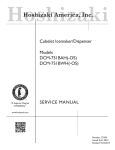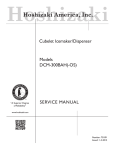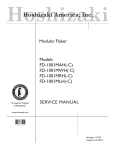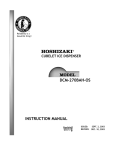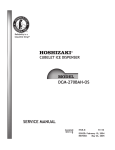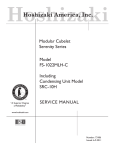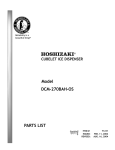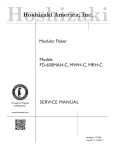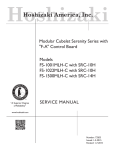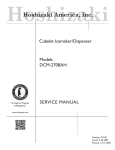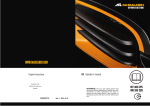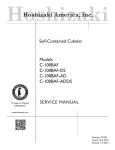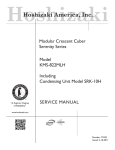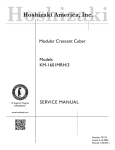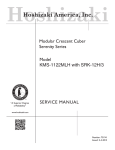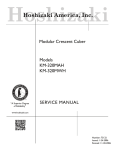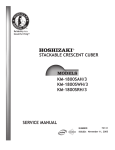Download Service Manual
Transcript
Hoshizaki Hoshizaki America, Inc. Cubelet Icemaker/Dispenser Models DCM-270BAH(-OS) F-A Control Board Models “A Superior Degree of Reliability” SERVICE MANUAL www.hoshizaki.com Number: 73202 Issued: 5-6-2014 Revised: 7-2-2014 WARNING Only qualified service technicians should install and service the icemaker. To obtain the name and phone number of your local Hoshizaki Certified Service Representative, visit www.hoshizaki.com. No service should be undertaken until the technician has thoroughly read this Service Manual. Failure to service and maintain the icemaker in accordance with this manual will adversely affect safety, performance, component life, and warranty coverage and may result in costly water damage. Proper installation is the responsibility of the installer. Product failure or property damage due to improper installation is not covered under warranty. Hoshizaki provides this manual primarily to assist qualified service technicians in the service and maintenance of the icemaker. Should the reader have any questions or concerns which have not been satisfactorily addressed, please call, send an e-mail message, or write to the Hoshizaki Technical Support Department for assistance. Phone: 1-800-233-1940; (770) 487-2331 Fax: 1-800-843-1056; (770) 487-3360 E-mail: [email protected] HOSHIZAKI AMERICA, INC. 618 Highway 74 South Peachtree City, GA 30269 Attn: Hoshizaki Technical Support Department Web Site: www.hoshizaki.com NOTE: To expedite assistance, all correspondence/communication MUST include the following information: • Model Number ________________________ • Serial Number ________________________ • Complete and detailed explanation of the problem. 2 IMPORTANT This manual should be read carefully before the icemaker is serviced. Read the warnings and guidelines contained in this booklet carefully as they provide essential information for the continued safe use, service, and maintenance of the icemaker. Retain this booklet for any further reference that may be necessary. CONTENTS Important Safety Information.................................................................................................. 5 I. Construction and Water Refrigeration Circuit Diagrams...................................................... 7 A. Construction................................................................................................................... 7 B. Water/Refrigeration Circuit Diagrams............................................................................. 8 II. Sequence of Operation and Service Diagnosis.................................................................. 9 A. Sequence of Operation Flow Chart................................................................................ 9 B. Service Diagnosis........................................................................................................ 10 C. Control Board Check.................................................................................................... 14 D. Bin Control Check........................................................................................................ 23 E. Float Switch Check and Cleaning................................................................................ 24 F. Diagnostic Tables.......................................................................................................... 26 III. Controls and Adjustments................................................................................................ 29 A. Control Board Layout................................................................................................... 30 B. LED Lights and Audible Alarm Safeties........................................................................ 32 C. Settings and Adjustments............................................................................................. 33 1. Default Dip Switch Settings..................................................................................... 33 2. Bin Control Shutdown Delay (Infrared Sensor) (S1 dip switch 1, 2, 3)................... 33 3. Drain Frequency Control (S1 dip switch 4)............................................................. 33 4. Continuous Dispensing Timer (S1 dip switch 5 & 6)............................................... 34 5. Bin Control Selector (S1 dip switch 7).................................................................... 34 6. Bin Control Shutdown Delay (S1 dip switch 8)....................................................... 34 7. Factory Use (S1 Dip Switch 9 & 10)........................................................................ 34 D. Switches....................................................................................................................... 35 IV. Removal and Replacement of Components.................................................................... 36 A. Service for Refrigerant Lines........................................................................................ 36 1. Refrigerant Recovery.............................................................................................. 37 2. Brazing................................................................................................................... 37 3. Evacuation and Recharge (R-404A)....................................................................... 37 B. Important Notes for Component Replacement............................................................. 38 C. Icemaking Unit............................................................................................................. 40 1. Upper Bearing Wear Check ................................................................................... 40 2. Removal and Replacement of Extruding Head....................................................... 41 3. Removal and Replacement of Auger...................................................................... 41 4. Removal and Replacement of Evaporator.............................................................. 42 5. Removal and Replacement of Mechanical Seal and Lower Housing .................... 43 6. Removal and Replacement of Gear Motor............................................................. 45 3 V. Maintenance..................................................................................................................... 46 VI. Preparing the Icemaker for Periods of Non-Use.............................................................. 47 VII. Disposal.......................................................................................................................... 48 VIII. Technical Information..................................................................................................... 49 A. Specification and Performance Data............................................................................ 49 1. DCM-270BAH......................................................................................................... 49 2. DCM-270BAH-OS.................................................................................................. 50 B. Wiring Diagrams........................................................................................................... 51 1. DCM-270BAH(-OS) ................................................................................................ 51 2. DCM-270BAH(-OS)................................................................................................ 52 4 Important Safety Information Throughout this manual, notices appear to bring your attention to situations which could result in death, serious injury, damage to the appliance, or damage to property. WARNING Indicates a hazardous situation which could result in death or serious injury. NOTICE Indicates a situation which could result in damage to the appliance or property. IMPORTANT Indicates important information about the use and care of the appliance. WARNING The appliance should be destined only to the use for which it has been expressly conceived. Any other use should be considered improper and therefore dangerous. The manufacturer cannot be held responsible for injury or damage resulting from improper, incorrect, and unreasonable use. Failure to service and maintain the appliance in accordance with this manual will adversely affect safety, performance, component life, and warranty coverage and may result in costly water damage. To reduce the risk of death, electric shock, serious injury, or fire, follow basic precautions including the following: • Only qualified service technicians should install and service the appliance. • The appliance must be installed in accordance with applicable national, state, and local codes and regulations. • The appliance requires an independent power supply of proper capacity. See the nameplate for electrical specifications. Failure to use an independent power supply of proper capacity can result in a tripped breaker, blown fuse, damage to existing wiring, or component failure. This could lead to heat generation or fire. • THE APPLIANCE MUST BE GROUNDED: The appliance is equipped with a NEMA 5-15 three‑prong grounding plug to reduce the risk of potential shock hazards. It must be plugged into a properly grounded, independent 3-prong wall outlet. If the outlet is a 2-prong outlet, it is your personal responsibility to have a qualified electrician replace it with a properly grounded, independent 3-prong wall outlet. Do not remove the ground prong from the power cord and do not use an adapter plug. Failure to properly ground the appliance could result in death or serious injury. • Do not use an extension cord. • To reduce the risk of electric shock, do not touch the control switch or plug with damp hands. Make sure the control switch is in the "OFF" position before plugging in or unplugging the appliance. • Do not use an appliance with a damaged power cord. The power cord should not be altered, jerked, bundled, weighed down, pinched, or tangled. Such actions could result in electric shock or fire. To unplug the appliance, be sure to pull the plug, not the cord, and do not jerk the cord. 5 WARNING, continued • Do not make any alterations to the appliance. Alterations could result in electric shock, injury, fire, or damage to the appliance. • Do not place fingers or any other objects into the ice discharge opening. • The appliance is not intended for use by persons (including children) with reduced physical, sensory, or mental capabilities, or lack of experience and knowledge, unless they have been given supervision or instruction concerning use of the appliance by a person responsible for their safety. • Young children should be properly supervised around the appliance. • Do not climb, stand, or hang on the appliance or appliance door or allow children or animals to do so. Serious injury could occur or the appliance could be damaged. • Do not use combustible spray or place volatile or flammable substances near the appliance. They might catch fire. • Keep the area around the appliance clean. Dirt, dust, or insects in the appliance could cause harm to individuals or damage to the appliance. NOTICE • Follow the water supply, drain connection, and maintenance instructions carefully to reduce the risk of costly water damage. • In areas where water damage is a concern, install in a contained area with a floor drain. • Install the appliance in a location that stays above freezing. Normal operating ambient temperature must be within 45°F to 100°F (7°C to 38°C). • Do not leave the appliance on during extended periods of non-use, extended absences, or in sub-freezing temperatures. To properly prepare the appliance for these occasions, follow the instructions in "VI. Preparing the Appliance for Periods of Non‑Use." • Do not place objects on top of the appliance. • The storage bin is for ice use only. Do not store anything else in the storage bin. 6 I. Construction and Water Refrigeration Circuit Diagrams A. Construction DCM-270BAH DCM-270BAH-OS 7 B. Water/Refrigeration Circuit Diagrams DCM-270BAH(-OS) Bin Inlet Water Valve Water Supply Reservoir Water Level Float Switch Overflow Evaporator Bin Drain Hose Thermostatic Expansion Valve Evaporator Water Supply Hose To Drain Gear Motor To Drain Drain Valve Dispense Water Valve Drier Fan High-Pressure Switch Air-Cooled Condenser Compressor Refrigeration Circuit Water Circuit 8 Maximum 90 seconds 5 sec. 5 minutes To bypass, press the "SERVICE" button after GM starts. 2. Ice Purge Cycle 9 (S1 dip switch 4) 3. 1-in-12 Drain Cycle & Restart (optional) 2. Bin Control Shutdown & Restart WV energized FT starts (90 sec.) 6 to 10 sec. 2. Ice Purge Cycle Comp de-energized FM de-energized GM energized Ice level lowered 3. Icemaker Restart UFS open LFS open FT starts (90 sec.) WV energized Comp energized FM energized GM energized DV energized GM de-energized eeded to "1. Fill Cycle" above A. Sequence of Operation Flow Chart Legend: BC-bin control Comp-compressor DC-drain cycle DT-drain timer DV-drain valve FM-fan motor FT-fill timer (low water safety) GM-gear motor LFS-lower float switch PT-purge timer UFS-upper float switch WV-inlet water valve 1-beep alarm continues WV energized GM de-energized inates PT term When UFS closes, alarm resets and 2. Ice Purge Cycle starts. 1-beep alarm sounds PT starts UFS open WV energized Comp de-energized FM de-energized GM energized to "2. Ice Purge Cycle" above 4. Icemaker Restart 10-min. DT terminates DV de-energized 1-in-12 DT reset 3. 10-Minute Drain FT exc 90 seconds Low Water Safety 90 sec. FT exceeded 1-beep alarm sounds 90 sec. PT starts LFS closed UFS closed FT terminates WV de-energized Comp energized FM energized GM energized Maximum 90 seconds BC closed (BC large balance plate disengaged) Comp energized FM energized GM energized 2. Icemaker Off 5 minutes 3. Freeze Cycle 1-in-1 drain cycle. DV energizes for 2 seconds every hour (S1 Dip Switch 4). Refill Does not affect operation. All Components de-energized 1. DT Initiates DC BC open (BC large balance plate engaged) 1. Bin Full LFS closed GM energized UFS closed FT terminates WV de-energized If Fill > 90 sec. FT 1-beep alarm sounds WV energized When UFS closes alarm resets and 2. Ice Purge Cycle starts. Power Switch "ON" Control Switch in "ICE" "POWER OK" LED on 1. Startup 1. Fill Cycle 4. 1-in-12 Drain Cycle - Although the factory default 1-in-1 drain cycle is recommended, a 1-in-12 drain cycle is available. For 1-in-12 drain cycle sequence, see "3. 1-in-12 Drain Cycle & Restart (optional)." "F-A" Control Board Sequence Flow Chart DCM-270B_H(-OS) II. Sequence of Operation and Service Diagnosis B. Service Diagnosis WARNING • The appliance should be diagnosed and repaired only by qualified service personnel to reduce the risk of death, electric shock, serious injury, or fire. • Risk of electric shock. Use extreme caution and exercise safe electrical practices. • Moving parts (e.g., fan blade) can crush and cut. Keep hands clear. • CHOKING HAZARD: Ensure all components, fasteners, and thumbscrews are securely in place after the appliance is serviced. Make sure that none have fallen into the storage bin. • Make sure all food zones in the appliance are clean after service. For cleaning procedures, see the instruction manual or the maintenance label. 1. Ice Production Check To check ice production, remove the front, top, and left side panels. Place a container under the spout and dispense all ice from the icemaker. Note: The ice dispense switch times out after 20 sec. Re-engage every 20 sec. until bin is empty. Move the control switch and power switch to the "OFF" position. Remove the bin top cover. Pour warm water over the remaining ice. After the ice is removed/melted, place the bin top cover in its original position. Do not secure at this time. Remove the control box cover, then move the control switch to the "ICE" position and the power switch to the "ON" position. Once the gear motor starts, press the "SERVICE" button on the control board (located in the control box). WARNING! Risk of electric shock. Care should be taken not to touch live terminals. Lift the bin top cover and monitor the evaporator extruding head. WARNING! Keep hands, hair, and loose clothing clear of the agitator rotating inside of the storage bin. Once ice begins to fill the bin, start a 10 min. timer. After 10 min., move the power switch to the "OFF" position. Place an empty container under the spout and dispense all ice from the icemaker. Note: The ice dispense switch times out after 20 sec. Re-engage every 20 sec. until bin is empty. Move the power switch to the "OFF" position. Weigh the ice to establish the batch weight (minus the weight of the container). Multiply the batch weight by 144 for the total production in 24 hr. Replace the control box cover and bin top cover in their original positions and secure. Replace all panels in their original positions and secure. Move the power switch to the "ON" position to start the automatic icemaking process. 10 2. Diagnostic Procedure The diagnostic procedure is a sequence check that allows you to diagnose the electrical system and components. Before proceeding, check for correct installation, adequate water pressure (10 to 113 PSIG), and proper voltage per unit nameplate. Note: • When checking high voltage (115VAC), always choose a neutral (W) wire to establish a good neutral connection. • When checking low voltage (24VAC), always choose a neutral (LBU) wire. • When checking control board DC voltage (5VDC), always place the red positive test lead from the multimeter to CB K5 pin closest to CB K4 connector. See "II.C. Control Board Check." • To speed up the diagnostic process, the 5-min. ice purge cycle may be bypassed by pressing the "SERVICE" button on the control board after the gear motor starts. WARNING! Risk of electric shock. Care should be taken not to touch live terminals. 1) Move the power switch to the "OFF" position, then disconnect the power cord from the electrical outlet. Remove the front, top, and left side panels. Remove the control box cover. 2) Reconnect the power cord into the electrical outlet, then move the power switch to the "ON" position. 3) Move the control switch to the "DRAIN" position. CB "POWER OK" LED and "FLUSH" (drain) LED turns on. Diagnosis "POWER OK" LED: Check that CB "POWER OK" LED is on. If not, check for 115VAC at control transformer brown (BR) wire to neutral (W). If 115VAC is not present, check the power switch, power cord connection, and breaker. If 115VAC is present, check control transformer continuity. Replace as needed. Next, check for 24VAC at control transformer red (R) wire to neutral (LBU). If 24VAC is not present, check control transformer continuity. Replace as needed. If 24VAC is present, check 24VAC 1A fuse. If fuse is good, check for 24VAC at CB K8 #1 (W/R) to CB K8 #2 (LBU). If 24VAC is present and "POWER OK" LED is off, replace CB. Diagnosis DV: If DV does not energize, check for 24VAC at CB K2 #10 (W/DBU) to neutral (LBU). If 24VAC is not present, check control switch continuity. If open while in the "DRAIN" position, replace control switch. If closed, check for 0VDC at control board K9 #1 (W/BK) to K9 #2 (W/BK). If 5VDC is present and control switch is closed, replace CB. If 24VAC is present, check for restricted DV and DV solenoid continuity. Clean or replace as needed. 3) After all of the water has drained, move control switch to the "ICE" position. 11 4) Fill Cycle – "WTRIN" LED is on. WV energizes. The 90-sec. low water safety timer begins. LFS closes. Nothing occurs at this time. The reservoir continues to fill until UFS closes, terminating the 90‑sec. low water safety timer, starting the 30‑min. freeze timer, and de-energizing WV. Diagnosis: Check that "WTRIN" LED turns on and water fills the reservoir. If not, check for water supply line shut‑off valve closed, restricted water filters, and restricted WV screen. Next, check for 24VAC at CB K2 #8 (W/BR) to neutral (LBU). If 24VAC is not present, replace CB. If 24VAC is present, turn off the power switch, disconnect the WV wires and check WV solenoid continuity. If open, replace WV. Reconnect WV wires, move the power switch to the "ON" position, then check that DV is not leaking by. Check that WV shuts off when UFS closes. Note: Low Water Safety– If UFS remains open 90 sec. after WV energizes, a 1‑beep alarm sounds. This alarm resets automatically once UFS closes. 5) Ice Purge Cycle – "GM" LED is on. 5-sec. GM delay timer and 30‑min. freeze timer start. WV de-energizes and "WTRIN" LED turns off. Once the 5‑sec. GM delay timer terminates, GM and CDR energize. CDR cannot energize unless GM circuit is complete (fuse, internal protector, and windings). Once CDR energizes, CB K9 #5 W/O and CB K9 #6 W/O 5VDC circuit closes and 5-min. ice purge timer starts. See "II.C.3)c. Compressor Delay Relay (5-min. Ice Purge Timer Circuit)." If CDR de‑energizes, CB K9 #5 W/O and CB K9 #6 W/O circuit opens and an 8-beep alarm occurs. See "III.B. LED Lights and Alarm Safeties." Note: To bypass ice purge cycle and go straight to freeze cycle, press "SERVICE" button on CB during 5-sec. GM delay time. Diagnosis CB: Check that UFS closed, WV LED turned off and WV de‑energized. If UFS is closed, "WV" LED is off, and "GM" LED is off, replace CB. If "GM" LED is on and GM is off, confirm 115VAC at CB K1 #2 (BR) to neutral (W). If 115VAC is not present, check for loose connection from power switch. If 115VAC is present, check for 115VAC at CB K1 #3 (BK) to neutral (W). If 115VAC is not present, replace CB. Diagnosis GM: If 115VAC is present at CB K1 #2 (BR) to neutral (W), check GM fuse, GM capacitor, GM windings, and GM coupling between auger and GM. Diagnosis CDR: See "II.C.3)c. Compressor Delay Relay (5-min. Ice Purge Timer Circuit)." Once 5-min. ice purge timer terminates, freeze cycle begins. 6) Freeze Cycle – "COMP" LED is on. 5-min. ice purge timer terminates or "SERVICE" button pressed. "COMP" LED turns on. "GM" LED remains on. Comp and FM energize. GM and CDR continue. Ice production begins 4 to 6 minutes after Comp energizes depending on ambient and water conditions. Diagnosis Comp: Check that "COMP" LED is on and that Comp energizes. If "COMP" LED is off, confirm 5-min. ice purge timer has terminated. Check for 0VDC across CB K9 #3 (W/O) and CB K9 #5 (W/O). If 5VDC is present, CDR contacts are open. Check for 115VAC at CDR #7 (O) to CDR #8 (W). If 115VAC is present, check CDR continuity between CDR #3 (W/O) and CDR #5 (W/O). If open, replace CDR. If closed and "COMP" LED remains off, replace CB. If "COMP" LED is on and Comp is off, check for 115VAC at each CB X1 brown (BR) wire to neutral (W). If 115VAC is present on one and not the other, replace CB. If 115VAC is present on both, check Comp windings, start relay, and capacitors. Note: If CDR de‑energizes, CB K9 #5 W/O and CB K9 #6 W/O circuit opens, Comp de‑energizes and an 8-beep alarm occurs. See "III.B. LED Lights and Alarm Safeties." Diagnosis FM: If FM does not energize, check FM capacitor, windings, and bearings. 12 7) Refill Cycle/Low Water Safety – As ice is produced, the water level in the reservoir drops. UFS opens. Nothing occurs at this time. When LFS opens, WV energizes, 90‑sec. low water safety timer (fill timer) starts. Comp, GM, CDR, and FM continue. When UFS closes, WV de-energizes, 90-sec. low water safety timer (fill timer) terminates and 30‑min. freeze timer resets. If UFS remains open 90 sec. after WV energizes (fill timer exceeded), a 90-sec. shutdown cycle starts. Comp and FM de‑energize and CB signals a 1-beep alarm every 5 sec. 90-sec. ice purge timer starts. GM and CDR continue to clear ice from the evaporator. 90-sec. purge timer terminates, GM and CDR de‑energize. WV and 1-beep alarm continue until UFS closes. Diagnosis – Check that "WTRIN" LED is on. If not, check LFS. See "II.E. Float Switch Check and Cleaning." If LFS is open and "WTRIN" LED is off, replace CB. If "WTRIN" LED is on, check that the reservoir fills. If not, check the water supply line, restricted water filters, WV solenoid, restricted WV screen. If WV is energized and refill exceeds 90-sec. low water safety timer (fill timer), check DV leaking by or open UFS. See "II.E. Float Switch Check and Cleaning." Note: Each time UFS closes, 30-min. freeze timer starts. The 30-min. freeze timer resets when UFS closes again. If UFS does not close again within 30 min., CB shuts down the unit and sounds a 5-beep alarm every 5 sec. See "II.B. LED Lights and Alarm Safeties." 10) Shutdown – Bin fills with ice activating BC microswitch. Within 10 sec. control board shutsdown unit. Diagnosis: Check that BC large balance plate is activated and not sticking. Check BC microswitch continuity. When BC large balance plate is down (icemaking), BC microswitch is closed. When BC large balance plate is up BC microswitch is open. If not, replace BC microswitch. If BC microswitch is open and Comp, FM, and GM do not de‑energize, replace CB. See "II.C. Control Board Check Procedure." Legend: BC–bin control; CB–control board; CDR–compressor delay relay; Comp–compressor; CT–control transformer; DV–drain valve; FM–fan motor; GM–gear motor; LFS–lower float switch; UFS–upper float switch; WV–inlet water valve 13 C. Control Board Check Before replacing a CB that does not show a visible defect and that you suspect is bad, always conduct the following check procedure. This procedure will help you verify your diagnosis. Before proceeding, check for proper voltage per appliance nameplate. Check that the 24VAC 1A fuse and 115VAC 3A GM breaker are good. • Check the S1 dip switch settings to assure that they are in the factory default position. For factory default settings, see "III.C.1. Default Dip Switch Settings." S1 dip switch 7 determines bin control application. WARNING! Do not adjust S1 dip switch 7 out of the factory default position. This dip switch must be left in the factory default position or the appliance will not operate correctly. • When checking for 115VAC high‑voltage (primary), always choose a 115VAC neutral (W) to establish a good neutral connection. • When checking for 24VAC low-voltage (secondary), always choose a 24VAC neutral (LBU) to establish a good neutral connection. If the appliance is in alarm, see "III.B. LED Lights and Audible Alarm Safeties." • When checking for 5VDC, use CB red K4 connector pin closest to CB black K3 connector for DC ground (GND). 14 1) Startup-"POWER OK" LED on: Move control switch to "ICE" position, then move power switch to "ON" position. "POWER OK" LED turns on. "POWER" LED remains on unless power supply is interrupted. NOTICE! Appliance will not start unless the safety switch is engaged. Diagnosis: Check that "POWER OK" LED is on. If not, check for proper 115VAC supply voltage to CT (main breaker or fuse and power switch). Next, check for proper 24VAC output from CT. Next, check that 1A fuse is good. Check for 24VAC from CB K8 connector pin #1 (W/R) to CB K8 connector pin #2 (LBU). If 24VAC is present and "POWER OK" LED is off, replace CB. 2) 5VDC Output Checks: There are seven 5VDC circuits on the appliance. a) 3 circuits at CB K9 connector: Control switch "DRAIN" position, high-pressure switch (HPS), and compressor delay relay (CDR). b) 2 circuits at CB K8 connector: Bin control (BC) and float switch (FS upper and lower). c) 2 circuits at CB K7 connector: Ice dispense (push button, and OS sensor), and water dispense (push button and OS sensor). 2a) 5VDC CB K9 Connector: See Fig. 1. 5VDC CB K9 Connector Component Pin # (Wire Color) Control Switch "DRAIN" Position #1 (W/BK) and #2 (W/BK) High-Pressure Switch (HPS) #3 (Y) and #4 (Y) Compressor Delay Relay (CDR) #5 (W/O) and #6 (W/O) (CDR relay terminals #3 W/O and #5 W/O) Red positive test lead to red K4 connector pin closest to black K3 connector Multimeter 5VDC Black Negative Test Lead Red Positive Test Lead "DRAIN" Position on Control Switch (W/BK) High-Pressure Switch (HPS) (Y) Compressor Delay Relay (CDR) CDR Terminals #3 (W/O) and #5 (W/O) Control Board K9 Connector Fig. 1 15 2a) 5VDC CB K9 Connector Continued: a) Control Switch"DRAIN" Position CB K9 connector pins #1 (W/BK) and #2 (W/BK): • "ICE" Position: When the control switch is in the "ICE" position, CB K9 connector pin #1 and pin #2 are open. 5VDC is present between CB K9 connector pin #1 (W/BK) and pin #2 (W/BK). If not, confirm 5VDC between pin #1 (W/BK) and CB red K4 connector, pin closest to CB black K3 connector. If 5VDC is not present, replace CB. • "DRAIN" Position: When control switch is in the "DRAIN" position, CB K9 connector pin #1 (W/BK) and pin #2 (W/BK) are closed. 5VDC is present between both CB K9 connector pin #1 (W/BK) and pin #2 (W/BK) to CB red K4 connector, pin closest to CB black K3 connector. If 5VDC is not present, replace CB. b) High-Pressure Switch (HPS) CB K9 connector pins #3 (Y) and #4 (Y): When HPS is closed, 5VDC is present between both CB K9 connector pins #3 (Y) and pin #4 (Y) to CB red K4 connector pin closest to CB black K3 connector. If 5VDC is not present on pin #3 (Y) or pin #4 (Y), replace CB. If 5VDC is present on CB K9 connector pin #3 (Y) and not on CB K9 connector pin #4 (Y), HPS is most likely open. CB sounds a 3-beep alarm. Check HPS continuity. If HPS is open and CB is not in alarm, replace CB. c) Compressor Delay Relay (CDR) CB K9 connector pins #5 (W/O) and #6 (W/O): When CDR is de‑energized (GM off), CDR terminals #3 and #5 are open and 5VDC is present between CB K9 connector pin #5 (W/O) and CB K9 connector pin #6 (W/O). If 5VDC is not present, check CDR continuity between terminals #3 and #5. If open, replace CB. When CDR is energized, CDR terminals #3 and #5 close and 0VDC is present between CB K9 connector pin #5 (W/O) and pin #6 (W/O). 5VDC is present between CB K9 connector pin #5 (W/O) to CB red K4 connector pin closest to CB black K3 connector and CB K9 connector pin #6 (W/O) to CB red K4 connector pin closest to CB black K3 connector. If GM is energized and CDR terminals #3 & #5 are open, an 8-beep alarm occurs. See "III.B. LED Lights and Audible Alarm Safeties." If CDR terminals #3 and #5 are closed and 0VDC is present between CB K9 connector pin #5 (W/O) and pin #6 (W/O), 5-min. Comp delay timer starts. If Comp does not energize after 5-min. delay timer terminates, replace CB. 16 2b) 5VDC CB K8 Connector: See Fig. 2. 5VDC CB K8 Connector Component Pin # (Wire Color) Bin Control (BC) #3 (GY) and #4 (GY) Float Switch (FS) Common #5 (BK) Common Red positive test lead to red K4 connector pin closest to black K3 connector Upper Float Switch (UFS) #6 (R) Lower Float Switch (LFS) #7 (BU) Multimeter 5VDC Red Positive Test Lead Black Negative Test Lead Control Board K8 Connector Bin Control (GY) Lower Float Switch (LFS) (BU) Float Switch (FS) Common (BK) Upper Float Switch (UFS) (R) Fig. 2 2b) 5VDC CB K8 Connector Continued: a) Bin Control (BC) CB K8 connector pins #3 (GY) and #4 (GY): When BC is closed (icemaking), 5VDC is present between CB K8 connector pin #3 (GY) and pin #4 (GY) to CB red K4 connector pin closest to CB black K3 connector. If 5VDC is not present on either pin, replace CB. If 5VDC is present on pin #3 (GY) and not on pin #4 (GY), BC is open. See "II.D. Bin Control Check." b) Float Switch (FS): Upper (UFS) and Lower (LFS): CB K8 connector pins #5 common (BK), #6 UFS (R), and #7 LFS (BU): 5VDC is present between CB K8 connector pin #5 common (BK) and CB red K4 connector pin closest to CB black K3 connector at all times. If 5VDC is not present, replace CB. For further float switch diagnostics, see "II.E. Float Switch Check and Cleaning." 17 2c) 5VDC CB K7 Connector: See Figs. 3, 4, 5, and 6. a) Water Dispense 1. Push Button Model CB K7 connector pins #3 (W/BK) and #8 (P): "WTRDP" LED is on: Before engaging the water dispense switch, check for the correct VDC from the locations given in the "Disengaged" column in the table below. If the VDC is different than in the table, replace CB. If the VDC is correct, engage the water dispense switch. "WTRDP" LED turns on. If not, confirm that the water dispense signal VDC matches the "Engaged" column in the table below. If not, check the water dispense switch continuity when engaged (closed). If the water dispense switch is open when engaged, replace the water dispense switch. If the VDC matches the "Engaged" column below and the "WTRDP" LED does not turn on, replace CB. Component 5VDC Power Supply Water Dispense Signal 5VDC CB K7 Connector Pin # (Wire Color) To CB VDC Ground Disengaged Engaged #3 (W/BK) 5VDC 5VDC Red K4 pin closest To to black K3 #8 (P) 0VDC 5VDC Multimeter 5VDC Red positive test lead to red K4 connector pin closest to black K3 connector Red Positive Test Lead Black Negative Test Lead Control Board K7 Connector Water Dispense (W/BK) (5VDC power supply) Water Dispense (P) (switch signal) Fig. 3 18 2. Opti-Serve Model CB K8 connector pins #7 (R), #8 (P), and #9 (BK): Before engaging the water dispense OS sensor, check for the correct VDC from the locations given in the "Disengaged" column in the table below. If the VDC is different than in the table, replace CB. If the VDC is correct, engage the OS sensor. "WTRDP" LED turns on. If not, confirm that the water dispense signal VDC matches the "Engaged" column in the table below. If not, replace the OS sensor. If the VDC matches the "Engaged" column below and the "WTRDP" LED does not turn on, replace CB. Component VDC Sensor Ground Water Dispense Signal 5VDC Power Supply 5VDC CB K7 Connector Pin # (Wire Color) To CB VDC Ground #7 (R) To Red K4 pin closest #8 (P) to black K3 #9 (BK) Disengaged Engaged 0VDC 0VDC 0VDC 5VDC 5VDC 5VDC Multimeter Red positive test lead to red K4 connector pin closest to black K3 connector Red Positive Test Lead 5VDC Black Negative Test Lead Control Board K7 Connector Water Dispense (BK) (5VDC power) Water Dispense (P) (switch signal) Fig. 4 19 Water Dispense (R) (VDC GND) b) Ice Dispense 1. Push Button Model CB K7 connector pins #2 (Y) and #3 (W/BK): "ICE" and "AM" LEDs are on: Before engaging the ice dispense switch, check for the correct VDC from the locations given in the "Disengaged" column in the table below. If the VDC is different than in the table, replace CB. If the VDC is correct, engage the ice dispense switch. "ICE" LED turns on. If not, check the ice dispense switch continuity when engaged (closed). If the ice dispense switch is open when engaged, replace. If the VDC matches the "Engaged" column below and the "ICE" LED does not turn on, replace CB. Component 5VDC Power Supply Ice Dispense Signal 5VDC CB K7 Connector Pin # (Wire Color) To CB VDC Ground Disengaged Engaged #3 (W/BK) 5VDC 5VDC Red K4 pin closest To to black K3 #2 (Y) 0VDC 5VDC Multimeter Red positive test lead to red K4 connector pin closest to black K3 connector 5VDC Red Positive Test Lead Black Negative Test Lead Control Board K7 Connector Ice Dispense (Y) (ice dispense signal) Ice Dispense (W/BK) (5VDC power supply) Fig. 5 20 2. Opti-Serve Model CB K8 connector pins #1 (W/R), #2 (Y), and #3 (W/BK): Before engaging the ice dispense OS sensor, check for the correct VDC from the locations given in the "Disengaged" column in the table below. If the VDC is different than in the table, replace CB. If the VDC reading is correct, engage the OS sensor. "ICE" LED turns on. If not, confirm that the ice dispense signal VDC matches the "Engaged" column in the table below. If not, replace the OS sensor. If the VDC matches the "Engaged" column below and the "ICE" LED does not turn on, replace CB. Component VDC Sensor Ground Ice Dispense Signal 5VDC Power Supply 5VDC CB K7 Connector Pin # (Wire Color) To CB VDC Ground #1 (W/R) To Red K4 pin closest #2 (Y) to black K3 #3 (W/BK) Disengaged 0VDC 0VDC Engaged 0VDC 5VDC 5VDC 5VDC Multimeter Red positive test lead to red K4 connector pin closest to black K3 connector Red Positive Test Lead 5VDC Black Negative Test Lead Control Board K7 Connector Ice Dispense (W/R) (VDC ground) Ice Dispense (Y) Ice Dispense (W/BK) (5VDC power supply) Fig. 6 21 (ice dispense signal) 3) Fill Cycle–"WTRIN" LED is on: "WTRIN" LED turns on only when the reservoir water level is low enough to open LFS. Diagnosis: Confirm LFS is open. If "WTRIN" LED is off and LFS is open and the control switch is in the "ICE" position (open), replace CB. If "WTRIN" LED is on and water is not filling the reservoir, check for 24VAC at CB K2 connector between pin #8 (O) and neutral (LBU). If the "WTRIN" LED is on and 24VAC is not present between CB K2 connector pin # 8 (O) and neutral (LBU), confirm 24VAC at CB K2 connector between pin #7 (W/R) and neutral (LBU). If 24VAC is present between CB K2 connector pin #7 (W/R) and neutral (LBU) and not between CB K2 connector pin #8 (O) and neutral (LBU), replace CB. 24VAC CB K2 Connector Connector K2 (CB input power) K2 (WV power) Pin # (Wire Color) Pin #7 (W/R) Pin #8 (O) To To Neutral (LBU) K8 pin #2 (LBU) LFS Open 24VAC 0VAC LFS Closed 24VAC 24VAC 4) Ice Purge Cycle–"GM" LED is on: "GM" LED turns on once UFS closes (reservoir full). If UFS is closed and "GM" LED is off, replace CB. If "GM" LED is on but GM does not start, check for 115VAC from CB K1 connector pin #3 (BK) to neutral (W). If 115VAC is not present, confirm 115VAC from CB K1 connector pin #2 (BR) to neutral (W). If 115VAC is present on CB K1 connector pin #2 (BR) but not on CB K1 connector pin #3 (BK), replace CB. Once GM energizes, CDR energizes and 5 min. PT starts. 5) Freeze Cycle–"GM" and "COMP" LED are on: 5-min. PT terminates or press the "SERVICE" button on CB after the "GM" LED turns on to bypass ice purge cycle. WARNING! Risk of electric shock. Care should be taken not to touch live terminals. After 5-min. PT terminates, "COMP" LED turns on. If not, confirm CDR conacts are closed. See step "2a)3. Compressor delay relay" above. If CDR contacts are closed, replace CB. If "COMP" LED turns on and Comp does not start, check for 115VAC from the CB X1 relay (BR) and (R) to neutral (W). If 115VAC is present on CB X1 relay (BR) and not on CB X1 relay (R), replace CB. Legend: AM–agitating motor (gear motor this model); BC–bin control; CB–control board; CDR–compressor delay relay; Comp–compressor; CT–control transformer; DV–drain valve; FM–fan motor; FT–fill timer (90‑sec. low water safety); GM–gear motor; PT–purge timer; LFS–lower float switch; UFS–upper float switch; WV–inlet water valve 22 D. Bin Control Check When BC (microswitch) is not engaged, BC circuit (CB K8 #3 (GY) and CB K8 #4 (GY)) is closed and the appliance produces ice. S1 dip switch 7 must be in the "OFF" position and S1 dip switch 8 must be in the "ON" position. When ice fills the bin and engages BC large balance plate, BC opens and CB shutsdown the appliance within 10 seconds. NOTICE! Do not place S1 dip switch 7 in the "ON" position or S1 dip switch 8 in the "OFF" position. For details, see "III.C.1. Default Dip Switch Settings." 1) Move the power switch to the "OFF" position. 2) Remove the front, top, and left side panels. 3) Move the control switch to the "OFF" position. 4) Remove the thumbscrews securing the storage bin cover. WARNING! Keep hands, hair, and loose clothing clear of the agitator rotating inside of the storage bin. 5) Disconnect BC connector from the back of the control box. 6) Check for continuity across BC microswitch. If BC large balance plate is not engaged and BC microswitch is open, replace BC microswitch. 7) Press and hold BC large balance plate. While BC large balance plate is engaged, check for continuity across BC microswitch. If BC large balance plate is engaged and BC microswitch is open, replace BC microswitch. 8) Disengage BC large balance plate. 9) Reconnect BC connector. Remove the control box cover. 10) Move the move the control switch to the "ICE" position, then move the power switch to the "ON" position. 11) Make sure the "GM" LED is on. There is a delay of at least 5 seconds before the "GM" LED turns on after power‑up. After the "GM" LED turns on, press the "SERVICE" button on CB to bypass the 5-min. ice purge timer. WARNING! Risk of electric shock. Care should be taken not to touch live terminals. "COMP" LED turns on. 12) When Comp starts, press and hold BC large balance plate. 13) Comp and GM should de‑energize within 10 seconds. Diagnosis: If not, and BC microswitch is found open and the appliance continues to run, replace CB. 14) Move the power switch to the "OFF" position. Leave the control switch in the "ICE" position. 15) Replace the storage bin cover and secure. 16) Replace the control box cover, left side, top, and front panels in their correct positions. 17) Move the power switch to the "ON" position to start the automatic icemaking process. Legend: BC–bin control; CB–control board; Comp–compressor;GM–gear motor 23 E. Float Switch Check and Cleaning 1. Float Switch Check 1) Remove the front, top, and left side panels, then move the control switch to the "DRAIN" position. 2) After the water has drained from the reservoir, remove the FS molex plug from the control box and check continuity across FS wires. Common (BK) to UFS (R) and common (BK) to LFS (BU). See Fig. 7. With the reservoir empty, float switches are open. If open, continue to step 3. If closed, follow the steps in "II.E.2. Float Switch Cleaning." After cleaning, check them again. Replace if necessary. 3) Replace the FS molex plug on the control box. 4) Move the control switch to the "ICE" position. 5) The reservoir fills. Once UFS closes GM starts. 6) Move the control switch to the "OFF" position. 7) Remove the FS molex plug from the control box and check continuity across FS wires. Common (BK) to UFS (R) and common (BK) to LFS (BU). With the reservoir full, float switches are closed. If open, follow the steps in "II.E.2. Float Switch Cleaning." After cleaning, check them again. Replace if necessary. 8) Move the control switch to the "ICE" position. 9) Replace the left side, top, and front panels in their correct positions. 2. Float Switch Cleaning Depending on water conditions, scale may build up on FS. Scale on the switch can cause the floats to stick. In this case, FS should be cleaned and checked. 1) Remove the front, top, and left side panels, then move the control switch to the "DRAIN" position. 2) After the water has drained from the reservoir, move the control switch to the "OFF" position and the power switch to the "OFF" position. 3) Remove FS assembly from the reservoir cover. See Fig. 8. 4) Wipe down FS assembly with a mixture of 1 part Hoshizaki Scale Away and 25 parts warm water. Rinse the FS assembly thoroughly with clean water. 5) While not necessary, the floats can be removed from the shaft during cleaning. If you remove them, note that the blue float is on top. The floats must be installed with the magnets inside them towards the top of the switch. See Fig. 8. Installing the floats upside down will affect the timing of FS operation. 6) Rinse FS assembly thoroughly with clean water and replace in its correct position. 7) Move the control switch to the "ICE" position. 7) Replace the left side, top, and front panels in their correct positions. 8) Move the power switch to the "ON" position to start the automatic icemaking process. Legend: Comp–compressor; FS–float switch; GM–gear motor 24 Red (R) (upper float switch) Black (BK) (common) Blue (BU) (lower float switch) Magnet (towards top) Upper Float (blue) Spring Retainer Clip Magnet (towards top) Lower Float (white) Plastic Retainer Clip Fig. 7 Float Switch Assembly Reservoir Cover Reservoir Fig. 8 25 F. Diagnostic Tables Before consulting the diagnostic tables, check for correct installation, proper voltage per appliance nameplate, and adequate water pressure (10 to 113 PSIG). Check control board using the steps in "II.C. Control Board Check." 1. No Ice Production No Ice Production - Possible Cause Startup 1. Power Supply a) Off, blown fuse, or tripped breaker. b) Loose connection. c) Not within specifications. 2. Power Switch a) "OFF" position. b) Defective. 3. Control Transformer a) Coil winding open or shorted. 4. 1A 24VAC Fuse (Control Box) a) Blown. 5. Control Switch a) In "DRAIN" position. b) Bad contacts. 6. Control Board See "II.C. Control Board Check" a) In alarm. See "III.B. LED Lights and Audible Alarm Safeties." 7. Bin Control a) Tripped with bin filled with ice. b) Defective. b) Microswitch defective. c) Large balance plate does not move freely. 8. High-Pressure Switch a) Control board in 3 or 4-beep alarm. See "III.B. LED Lights and Audible Alarm Safeties." Fill Cycle 1. Control Board a) No power to inlet water valve (24VAC). b) No power to float switch (5VDC) or not reading float switch condition. 2. Inlet Water Valve a) Screen or orifice clogged. b) Coil winding. 3. Water Supply a) Water supply off or improper water pressure. b) External water filters clogged. 4. Float Switch a) Float does not move freely. b) Defective. 5. Drain Valve a) Sticking. Ice Purge Cycle 1. Control Board a) No power to gear motor. 2. Gear Motor a) 3A breaker tripped. b) Internal protector open. c) Motor winding. d) Mechanical failure. 3. Coupling a) Defective. 4. Compressor Delay Relay a) Defective. 26 No Ice Production - Possible Cause Freeze Cycle 1. Control Board a) No power to compressor delay relay circuit (5VDC) or not reading circuit. b) Compressor relay defective 2. Start Relay a) Defective. 3. Start Capacitor a) Defective. 4. Compressor a) Internal protector. b) Motor winding. c) Mechanical failure. 5. High-Pressure Switch Activates a) Dirty condenser. b) Ambient temperature too warm. c) Fan motor not operating. d) Refrigerant overcharged. e) Defective. f) Refrigerant lines or components restricted. 6. Fan Motor a) Capacitor defective. b) Motor winding. c) Bearing worn out or locked rotor. 7. Evaporator a) Dirty. b) Damaged or defective. 8. Thermostatic Expansion Valve (TXV) a) Bulb loose. 9. Refrigerant Charge a) Low. 10. Drain Valve b) Operating erratically. a) Dirty, leaking by. b) Defective coil. c) Defective control board. 11. Water System a) Water leaks. Refill 1. Water Supply a) Off. 2. Control Board a) No power to float switch (5VDC) or not reading float switch condition. b) No power to inlet water valve (24VAC). 3. Float Switch a) Float does not move freely. b) Defective. 4. Inlet Water Valve a) Clogged or defective. Shutdown 1. Bin Control a) Large balance plate sticking. b) Microswitch defective. 2. Control Board a) Defective. 27 2. Ice/Water Dispensing Ice Dispense-Push Button 1. Power Supply a) Off, blown fuse, or tripped breaker. 2. Control Board a) No power from control board to ice dispense switch (5VDC) or not reading signal. b) No power to ice dispense solenoid or dispense relay (115VAC). 3. Ice Dispense Switch a) Defective. 4. Ice Dispense Solenoid a) Defective or loose connection. 5. Ice Dispense Relay a) Defective. 6. Gear Motor a) Defective. 7. Shutter Assembly a) Defective. Ice Dispense-Opti-Serve 1. Power Supply a) Off, blown fuse, or tripped breaker. 2. Control Board a) No power from control board to OS sensor (5VDC) or not reading signal. b) No power to ice dispense solenoid or dispense relay (115VAC). 3. OS Sensor (infrared) a) Defective. 4. Ice Dispense Solenoid a) Defective or loose connection. 5. Ice Dispense Relay a) Defective. 6. Gear Motor a) Defective. 7. Shutter Assembly a) Defective. Water Dispense-Push Button 1. Power Supply a) Off, blown fuse, or tripped breaker. 2. Control Board a) No power from control board to water dispense switch (5VDC) or not reading signal. b) No power to dispense water valve (24VAC). 3. Water Dispense Switch a) Defective. 4. Water Dispense Valve a) Water supply turned off. b) Defective. Water Dispense-Opti-Serve 1. Power Supply a) Off, blown fuse, or tripped breaker. 2. Control Board a) No power from control board to OS sensor (5VDC) or not reading signal. b) No power to water dispense valve (24VAC). 3. OS Sensor (infrared) a) Defective. 4. Water Dispense Valve a) Water supply turned off. b) Defective. 28 III. Controls and Adjustments • A Hoshizaki exclusive control board is employed in Hoshizaki icemakers. • All models are pre-tested and factory adjusted. • For a control board check procedure, see "II.C. Control Board Check." NOTICE • The control board is fragile; handle very carefully. • The control board contains integrated circuits, which are susceptible to failure due to static discharge. It is especially important to touch the metal part of the icemaker before handling or replacing the control board. • Do not touch the electronic devices on the control board or the back of the control board. • Do not change wiring and connections. Do not misconnect terminals. • Do not short out power supply to test for voltage. • Always replace the whole control board assembly if it goes bad. 29 A. Control Board Layout 1. DCM-270BAH Control Switch #1 to #2 (W/BK) "ICE"-Open-5VDC "DRAIN"-Closed-0VDC High-Pressure Switch #3 to #4 (Y) Open-5VDC Closed-0VDC Compressor Delay Relay Circuit #5 to #6 (W/O) Relay De-Energized-Open-5VDC Relay Energized-Closed-0VDC • K9 Connector • "SERVICE" Button (Ice Purge Cycle Bypass) Compressor Relay 115VAC input (BR) 115VAC output (R) Control Transformer 24VAC Input #1 (W/R) 115VAC • K1 Connector #3 GM (DBU) #2 GM Voltage Input (BR) 24VAC Control Transformer 24VAC Neutral #2 (LBU) • K2 Connector 5VDC Float Switch Output #5 (BK)(+) Upper Float Switch #6 (R) 24VAC Lower Float Switch #7 (BU) • K7 Connector Water/Ice Dispense Output #2 (Y) 115VAC Ice Dispense Input #3 (W/BK) 5VDC 24VAC Input #5 (W/R) Agitating Motor #4 (O) 115VAC Input #3 (BK) Bin Control #3 to #4 (GY) DRAIN Drain Valve #10 (W/DBU) Control Transformer Input #9 (W/R) Inlet Water Valve #8 (W/BR) Control Transformer Input #7 (W/R) Dispense Water Valve #6 (W/O) • K8 Connector 5VDC Dispense Motor #2 (P) 115VAC Input #3 (BK) LED Legend: COMP-compressor FLUSH (DRAIN)-drain valve GM-gear motor ICE-dispense motor WTRDP-water dispense valve WTRIN-inlet water valve Water Dispense Input #8 (P) • S1 Dip Switch 5VDC Ground (GND) Terminals • "POWER OK" LED • K6 Connector Open Fig. 9a 30 2. DCM-270BAH-OS Control Switch #1 to #2 (W/BK) "ICE"-Open-5VDC "DRAIN"-Closed-0VDC High-Pressure Switch #3 to #4 (Y) Open-5VDC Closed-0VDC Compressor Delay Relay Circuit #5 to #6 (W/O) Relay De-Energized-Open-5VDC Relay Energized-Closed-0VDC • K9 Connector • "SERVICE" Button (Ice Purge Cycle Bypass) Compressor Relay 115VAC input (BR) 115VAC output (R) 5VDC (24VAC and 5VDC) • K2 Connector 24VAC 115VAC • K1 Connector #3 GM (BK) #2 115VAC Input (BR) Drain Valve #10 (W/DBU) DRAIN 5VDC Ice Dispense Solenoid #2 (DBU) LED Legend: COMP-compressor FLUSH (Drain)-drain valve GM-gear motor ICE-dispense motor WTRDP-water dispense valve WTRIN-inlet water valve Upper Float Switch #6 (R) Open-5VDC to #5 black Closed-0VDC to #5 black Lower Float Switch #7 (BU) Open-5VDC to #5 black Closed-0VDC to #5 black OS Ice Sensor #1 (W/R) 115VAC Input #3 (BR) 115VAC Input 1 (BK) Control Transformer 24VAC Input #1 (W/R) Control Transformer 24VAC Neutral #2 (LBU) Bin Control #3 to #4 (GY) Open-5VDC Closed-0VDC Float Switch Output #5 (BK) • K7 Connector 115VAC Gear Motor (ice dispense) #4 (BK) 24VAC Control Transformer Input #7 (W/R) Dispense Water Valve #6 (W/O) 24VAC Input #5 (W/R) 5VDC Control Transformer Input #9 (W/R) Inlet Water Valve #8 (O) • K8 Connector Ice Dispense #2 (Y) Ice Dispense Output #3 (W/BK) • S1 Dip Switch • "POWER OK" LED • K6 Connector Open 5VDC Ground (GND) Terminals Fig. 9b 31 OS Water Sensor GND #7 (R) Water Dispense Signal #8 (P) OS Water Sensor Output #9 (BK)(+) B. LED Lights and Audible Alarm Safeties The "POWER" LED indicates proper control voltage and will remain on unless a control voltage problem occurs. For further details, see "II. Sequence of Operation and Service Diagnosis." Sequence Step Fill Cycle LED WTRIN Icemaking Sequence Energized Components Min. WV Max. On until UFS closes. Alarm sounds after 90 sec. 5 min. *On until UFS closes. Alarm sounds after 90 sec. Ice Purge Cycle GM GM 5 min. Freeze Cycle GM, WTRIN* (refill), GM, Comp, (with refill) COMP FM, WV* (refill) Drain Cycle FLUSH (Drain) DV 2 sec. 10 min. Dispensing Sequence **Dispense Mode Energized Sequence Step LED Time LEDs are on Components Continuous Ice Dispense ICE GM, **IDSV Factory set for IDSV de-energizes on internal Activation 20 sec. overload after 3 to 4 min. Resets when cool Dispense Water WTRDP Valve Activation DispWV The built-in alarm safeties shut down the appliance. No. of Beeps Type of Alarm (every 5 sec.) 1 Low Water Safety UFS open > 90 seconds after WV energized. 2 Control Switch In "DRAIN" position longer than 15 minutes. 3 High-Pressure Switch First and second activation in 1 hour. 4 High-Pressure Switch Third activation in 1 hour. 5 Freeze Timer WV off > 30 minutes since last WV activation. Low Voltage (92Vac ±5% or less) High Voltage (147Vac ±5% or more) Gear Motor Bin Control (Infrared Sensor) (S1 dip switch 7) (Not used on this model) 6 7 8 9 Reset Options Automatic reset once water supply is restored and UFS closes. Automatic reset once the control switch is moved to the "ICE" position. Automatic reset once pressure drops below the high pressure threshold and the high‑pressure switch closes. Call for service. To avoid possible catastrophic failure, it is recommended to leave the appliance off until this alarm is resolved. Manual reset. Turn power off and on again. Manual reset. Turn power off and on again. "POWER OK" LED turns off if voltage protection operates. The control voltage safeties automatically reset when voltage is corrected. Manual reset. Turn power off and on again. Manual reset. Turn power off and on again. Legend: Comp–compressor; DispWV–dispense water valve; DV–drain valve; FM–fan motor; GM–gear motor; IDSV–ice dispense solenoid valve; UFS–upper float switch; WV–inlet water valve 32 C. Settings and Adjustments 1. Default Dip Switch Settings The S1 dip switch settings are factory-set to the following positions: Dip Switch No. 1 2 3 4 5 DCM-270BAH(-OS) OFF OFF OFF OFF 6 ON 7 8 9 10 OFF OFF OFF OFF OFF Normally off (factory use) Bin Control Shutdown Delay (mechanical) and Periodic Agitation of Storage Bin Bin Control Selector Continuous Dispensing Timer (Do not adjust on DCM-270BAH-OS) Drain Frequency Control Bin Control Shutdown Delay (infrared sensor) 2. Bin Control Shutdown Delay (Infrared Sensor) (S1 dip switch 1, 2, 3) NOTICE Do not adjust. Setting not used on this model. When dip switch 7 is off, 1, 2, and 3 are ignored. Factory set. DCM-270BAH(-OS) does not use a bin control with an infrared sensor. The appliance uses a bin control with a mechanical microswitch for ice level control. 3. Drain Frequency Control (S1 dip switch 4) The appliance is factory set for optimum performance with the 1-in-1 drain cycle (S1 dip switch 4 in the "OFF" position). This setting allows for removal of sediment from the evaporator without interrupting the icemaking process. 1-in-12 drain cycle is available. S1 Dip Switch Setting No. 4 Drain Timer Interval Drain Valve Open OFF (1-in-1) 1 Hour 2 Seconds ON (1-in-12) 11 Hours 45 Minutes 10 Minutes 33 4. Continuous Dispensing Timer (S1 dip switch 5 & 6) The factory setting allows ice to be dispensed continuously for 20 sec. The DCM-270BAH may be adjusted to other dispense time options. NOTICE! On DCM-270BAH-OS, do not adjust S1 dip switch 5 & 6 out of the factory default position. S1 Dip Switch Setting Dispense Time No. 5 No. 6 OFF OFF No Limit ON OFF 20 Seconds OFF ON 60 Seconds ON ON No Limit Note: The ice dispense solenoid has an internal overload protector. When set to "No Limit" the internal protector may open if ice dispense solenoid is energized longer than 3 to 4 min. at one time. 5. Bin Control Selector (S1 dip switch 7) The appliance is factory set with mechanical bin control operation. No adjustment is required. In the factory default position (S1 dip switch 7 in the off position), the gear motor delay after the upper float switch closes is 5 seconds. WARNING! Do not adjust S1 dip switch 7 out of the factory default position. This dip switch must be left in the factory default position or the appliance will not operate correctly. S1 Dip Switch Setting Bin Control Application Gear Motor Delay No. 7 OFF Bin Control (Mechanical) 5 seconds ON Bin Control (Infrared Sensor) with Mechanical Bin Control Backup 30 seconds 6. Bin Control Shutdown Delay and Storage Bin Agitation Timer (S1 dip switch 8) Factory set for normal operation. No adjustment is required. The shutdown delay is the time between the bin control microswitch opening and the control board shutting off the appliance. A 2-second periodic agitation occurs every 90 minutes. S1 Dip Switch Setting No. 8 Bin Control #1 Storage Bin Shutdown Delay Periodic Agitation OFF 0.25 Seconds 2 Seconds ON 6.7 Seconds No Agitation 7. Factory Use (S1 Dip Switch 9 & 10) Factory set for optimum performance. Do not adjust. 34 D. Switches The power switch and control switch are used to control the operation of this icemaker. 1. Power Switch The power switch has 2 positions, "OFF" and "ON." 2. Control Switch The control switch is a double-pole double-throw switch with 3 positions, "ICE," "OFF," and "DRAIN." a) ICE When the control switch is in the "ICE" position, the control switch closes a 5VDC circuit from control board K4 connector pin #3 (W/R) to control board K4 connector pin #4 (W/R). When the control board receives 5VDC on K4 connector pin #4 (W/R), the control starts the icemaking process. b) OFF When the control switch is in the "OFF" position, the 5VDC circuits used for ice and drain are open and the unit is off. c) DRAIN When the control switch is in the "DRAIN" position, the control switch closes a 5VDC circuit from control board K4 connector pin #1 (W/BK) to control board K4 connector pin #2 (W/BK). When the control board receives 5VDC on K4 connector pin #2 (W/BK), the control board directs 24VAC to the drain valve and the drain valve energizes. 35 IV. Removal and Replacement of Components WARNING • This icemaker should be diagnosed and repaired only by qualified service personnel to reduce the risk of death, electric shock, serious injury, or fire. • Move the power switch to the "OFF" position and turn off the power supply to the icemaker before servicing. Lockout/Tagout to prevent the power from being turned back on inadvertently. • CHOKING HAZARD: Ensure all components, fasteners, and thumbscrews are securely in place after the equipment is serviced. Make sure that none have fallen into the storage bin. • Make sure all food zones in the icemaker and storage bin are clean after the icemaker is serviced. For cleaning procedures, see "VI. Cleaning and Maintenance." • When replacing evaporator assembly and water circuit components, make sure there are no water leaks after the repair is complete. A. Service for Refrigerant Lines WARNING • Repairs requiring the refrigeration circuit to be opened must be performed by properly trained and EPA-certified service personnel. • Always recover the refrigerant and store it in an approved container. Do not discharge the refrigerant into the atmosphere. • Use an electronic leak detector or soap bubbles to check for leaks. Add a trace of refrigerant to the system (if using an electronic leak detector), and then raise the pressure using nitrogen gas (140 PSIG). Do not use R‑404A as a mixture with pressurized air for leak testing. NOTICE • Do not leave the system open for longer than 15 minutes when replacing or servicing parts. The Polyol Ester (POE) oils used in R-404A units can absorb moisture quickly. Therefore it is important to prevent moisture from entering the system when replacing or servicing parts. • Always install a new drier every time the sealed refrigeration system is opened. • Do not replace the drier until after all other repair or replacement has been made. Install the new drier with the arrow on the drier in the direction of the refrigerant flow. • When brazing, protect the drier by using a wet cloth to prevent the drier from overheating. Do not allow the drier to exceed 250°F (121°C). 36 1. Refrigerant Recovery This icemaker is provided with refrigerant access valves. Using proper refrigerant practices, recover the refrigerant from the service valves and store it in an approved container. Do not discharge the refrigerant into the atmosphere. 2. Brazing WARNING • R-404A itself is not flammable at atmospheric pressure and temperatures up to 176°F (80°C). • R-404A itself is not explosive or poisonous. However, when exposed to high temperatures (open flames), R-404A can be decomposed to form hydrofluoric acid and carbonyl fluoride both of which are hazardous. • Do not use silver alloy or copper alloy containing arsenic. • Use an electronic leak detector or soap bubbles to check for leaks. Add a trace of refrigerant to the system (if using an electronic leak detector), and then raise the pressure using nitrogen gas (140 PSIG). Do not use R-404A as a mixture with pressurized air for leak testing. 1) Braze all fittings while purging with nitrogen gas flowing at a pressure of 3 to 4 PSIG. NOTICE • Always install a new drier every time the sealed refrigeration system is opened. • Do not replace the drier until after all other repair or replacement has been made. Install the new drier with the arrow on the drier in the direction of the refrigerant flow. • When brazing, protect the drier by using a wet cloth to prevent the drier from overheating. Do not allow the drier to exceed 250°F (121°C). 2) Use an electronic leak detector or soap bubbles to check for leaks. Add a trace of refrigerant to the system (if using an electronic leak detector), and then raise the pressure using nitrogen gas (140 PSIG). Do not use R-404A as a mixture with pressurized air for leak testing. 3. Evacuation and Recharge (R-404A) 1) Attach a vacuum pump to the system. Be sure to connect charging hoses to both high and low-side access valves. IMPORTANT The vacuum level and vacuum pump may be the same as those for current refrigerants. However, the rubber hose and gauge manifold to be used for evacuation and refrigerant charge should be exclusively for POE oils. 2) Turn on the vacuum pump. Open the gauge manifold valves. Never allow the oil in the vacuum pump to flow backwards. 3) Allow the vacuum pump to pull down to a 29.9" Hg vacuum. Evacuating period depends on pump capacity. 37 4) Close the low-side valve and high-side valve on the gauge manifold. 5) Disconnect the gauge manifold hose from the vacuum pump and attach it to a refrigerant service cylinder. Remember to loosen the connection and purge the air from the hose. See the rating label inside the icemaker for the required refrigerant charge. Hoshizaki recommends only virgin refrigerant or reclaimed refrigerant which meets ARI Standard 700 (latest edition) be used. 6) A liquid charge is required for charging an R-404A system (to prevent fractionation). Place the service cylinder on the scales: if the service cylinder is not equipped with a dip tube, invert the service cylinder, then place it on the scales. Open the high-side valve on the gauge manifold. 7) Allow the system to charge with liquid until the proper charge weight is met. 8) If necessary, add any remaining charge to the system through the low-side. NOTICE! To prevent compressor damage, use a throttling valve or liquid dispensing device to add the remaining liquid charge through the low-side access valve with the icemaker running. 9) Close the high and low-side gauge manifold valves, then disconnect the gauge manifold hoses. 10) Cap the access valves to prevent a possible leak. B. Important Notes for Component Replacement NOTICE When replacing a component listed below, see the notes to help ensure proper operation. Component Compressor Notes Install a new drier, start capacitor, and start relay. Expansion Valve • Install a new drier. • Attach the expansion valve bulb to the suction line in the same location as the previous bulb. • The bulb should be between the 10 and 2 o'clock positions on the tube. • Secure the bulb with the clamp and holder, then insulate it. Upper and Lower Bearings • Inspect the upper bearing for wear. See "IV.C.1. Upper Bearing Wear Check." Replace if necessary. • When replacing the upper bearing it is advised to also change the lower bearing at the same time. Evaporator • Install a new drier. • Inspect the mechanical seal and O-ring prior to installing the new evaporator. If worn, cracked, or scratched, the mechanical seal should also be replaced. Gear Motor Install a new gear motor capacitor. 38 Evaporator Assembly Cutter Extruding Head (Upper Bearing) Drip Ring Auger Cover "O"-Ring Seal Bolt Evaporator Socket Head Cap Screw Ring Mechanical Seal "O"-Ring Housing (Lower Bearing) Gear Motor Spline Coupling Socket Head Cap Screw Fig. 8 39 C. Icemaking Unit 1. Upper Bearing Wear Check To ensure that the bearing inside the extruding head does not exceed the wear tolerance of .02", follow the instructions below. See Fig. 3. 1) Move the control switch to the "OFF" position, then turn off the power supply. Remove the front and top panels, then move the power switch to the "OFF" position. 2) Remove the top of the storage bin, then remove the agitator by turning it counter clockwise. Next, lift the drip pan out of the storage bin area. 3) Grasp the top of the auger and move the auger towards you, then try to insert a Drip Ring .02" round stock or pin gauge in between the back side of the auger shaft and the bearing surface. Check several locations .02" Round Stock or Pin Gauge around the auger shaft. If the gauge goes between the shaft and the bearing at any point or if the bearing is scratched or cracked, both the top bearing in the extruding head and the lower bearing in the housing should be replaced. Instructions for Extruding removing the extruding head and housing Head are located later in this procedure. Note: Replacing the bearing requires a bearing press adaptor. If one is not available, replace the whole extruding head and housing. Agitator Auger Fig. 3 4) Replace the drip pan, agitator, and top of the storage bin in their correct positions. 5) Move the power switch to the "ON" position, then replace the panels in their correct positions. 6) Turn on the power supply, then move the control switch to the "ICE" position to start the automatic icemaking process. 40 2. Removal and Replacement of Extruding Head 1) Move the control switch to the "DRAIN" position and drain all of the water from the evaporator. 2) After the water has stopped draining, move the control switch to the "OFF" position, then turn off the power supply. Remove the front and top panels, then move the power switch to the "OFF" position. 3) Remove the front cover of the storage bin. Remove spout B, then remove spout A and the cutter. See Fig. 2. 4) Remove the apron panel, then remove the left side panel. 5) Remove the allen head cap screws and lift off the extruding head. 6) Place the new extruding head in place and tighten down the allen head cap screws. 7) Replace the cutter in its correct position. 8) Replace spout A, spout B, and the front cover of the storage bin in their correct positions. 9) Move the power switch to the "ON" position, then replace the panels in their correct positions. 10) Turn on the power supply, then move the control switch to the "ICE" position to start the automatic icemaking process. 3. Removal and Replacement of Auger 1) Move the control switch to the "DRAIN" position and drain all of the water from the evaporator. 2) After the water has stopped draining, move the control switch to the "OFF" position, then turn off the power supply. Remove the front and top panels, then move the power switch to the "OFF" position. 3) Remove the front cover of the storage bin. Remove spout B, then remove spout A. See Fig. 2. 4) Remove the apron panel, then remove the left side panel. 5) Remove the allen head cap screws securing the extruding head. Using the cutter, lift out the auger assembly. 6) Remove the cutter, extruding head, and upper part of the mechanical seal from the auger and place them on the new auger. NOTICE! To help prevent water leaks, be careful not to damage the surfaces of the O‑ring or mechanical seal. 7) Install the new auger assembly with the upper part of the mechanical seal attached and tighten down the allen head cap screws. 8) Replace spout A, spout B, and the front cover of the storage bin in their correct positions. 9) Move the power switch to the "ON" position, then replace the panels in their correct positions. 10) Turn on the power supply, then move the control switch to the "ICE" position to start the automatic icemaking process. 41 4. Removal and Replacement of Evaporator NOTICE • Always install a new drier every time the sealed refrigeration system is opened. • Do not replace the drier until after all other repair or replacement has been made. Install the new drier with the arrow on the drier in the direction of the refrigerant flow. • When brazing, protect the drier by using a wet cloth to prevent the drier from overheating. Do not allow the drier to exceed 250°F (121°C). 1) Move the control switch to the "DRAIN" position and drain all of the water from the evaporator. 2) After the water has stopped draining, move the control switch to the "OFF" position, then turn off the power supply. Remove the front and top panels, then move the power switch to the "OFF" position. 3) Remove the apron panel, then remove the left side panel. 4) Recover the refrigerant and store it in an approved container. 5) Remove the front cover of the storage bin. Remove spout B, then remove spout A. See Fig. 2. 6) Remove the allen head cap screws securing the extruding head. Using the cutter, lift out the auger assembly. 7) Remove the evaporator bracket and disconnect the water hoses. 8) Disconnect the inlet and outlet tubing. 9) Remove the allen head cap screws securing the evaporator to the lower housing. 10) Lift off the evaporator. 11) Inspect the mechanical seal and O-ring prior to installing the new evaporator. The mechanical seal consists of two parts. One moves along with the auger, and the other is fixed on the lower housing. NOTICE! If the contact surfaces of these two parts are worn, cracked, or scratched, the mechanical seal may cause water leaks and should be replaced. Instructions for removing the mechanical seal and lower housing are located later in this procedure. 12) Make sure the lower mechanical seal is in place, then place the new evaporator in position. Secure the evaporator to the lower housing using the allen head cap screws. 13) Remove the drier, then place the new drier in position. 14) Braze all fittings while purging with nitrogen gas flowing at a pressure of 3 to 4 PSIG. 42 15) Use an electronic leak detector or soap bubbles to check for leaks. Add a trace of refrigerant to the system (if using an electronic leak detector), and then raise the pressure using nitrogen gas (140 PSIG). Do not use R-404A as a mixture with pressurized air for leak testing. 16) Evacuate the system, and charge it with refrigerant. See the nameplate for the required refrigerant charge. 17) Install the auger assembly with the upper part of the mechanical seal attached and tighten down the allen head cap screws. 18) Replace the evaporator bracket and reconnect the water hoses. 19) Replace spout A, spout B, and the front cover of the storage bin in their correct positions. 20) Move the power switch to the "ON" position, then replace the panels in their correct positions. 21) Turn on the power supply, then move the control switch to the "ICE" position to start the automatic icemaking process. 5. Removal and Replacement of Mechanical Seal and Lower Housing 5a. Mechanical Seal 1) Move the control switch to the "DRAIN" position and drain all of the water from the evaporator. 2) After the water has stopped draining, move the control switch to the "OFF" position, then turn off the power supply. Remove the front and top panels, then move the power switch to the "OFF" position. 3) Remove the front cover of the storage bin. Remove spout B, then remove spout A. See Fig. 2. 4) Remove the apron panel, then remove the left side panel. 5) Remove the extruding head heater and the allen head cap screws securing the extruding head. 6) Using the cutter, lift out the auger assembly, then remove the evaporator bracket. 7) The mechanical seal consists of two parts. One moves along with the auger, and the other is fixed on the lower housing. NOTICE! If the contact surfaces of these two parts are worn, cracked, or scratched, the mechanical seal may cause water leaks and should be replaced. 8) Remove the allen head cap screws securing the evaporator to the lower housing. 9) Raise the evaporator up to access the lower housing. 10) Remove the mechanical seal from the housing. If only replacing the mechanical seal, proceed to step 13. NOTICE! To help prevent water leaks, be careful not to damage the surfaces of the O‑ring or mechanical seal. 43 5b. Lower Housing 11) Remove the O-ring and the bolts securing the housing to the gear motor and remove the housing from the gear motor. If inspection of the upper bearing inside the extruding head (see "IV.C.1. Upper Bearing Wear Check") indicates that it is out of tolerance, replace both it and the bearing inside the lower housing. Note: Replacing the bearing requires a bearing press adaptor. If one is not available, replace the whole extruding head and housing. 12) Install the O-ring and mount the lower housing on the gear motor. 13) Install the lower part of the mechanical seal on the lower housing. 14) Lower the evaporator down and secure it to the lower housing. 15) Install the auger assembly with the upper part of the mechanical seal attached. 16) Replace the evaporator bracket in its correct position. 17) Replace spout A, spout B, and the front cover of the storage bin in their correct positions. 18) Move the power switch to the "ON" position, then replace the panels in their correct positions. 19) Turn on the power supply, then move the control switch to the "ICE" position to start the automatic icemaking process. 44 6. Removal and Replacement of Gear Motor 1) Move the control switch to the "DRAIN" position and drain all of the water from the evaporator. 2) After the water has stopped draining, move the control switch to the "OFF" position, then turn off the power supply. Remove the front and top panels, then move the power switch to the "OFF" position. 3) Remove the front cover of the storage bin. Remove spout B, then remove spout A. See Fig. 2. 4) Remove the apron panel, then remove the left side panel. 5) Remove the evaporator bracket. 6) Remove the bolts securing the lower housing to the gear motor. Lift the evaporator up slightly. 7) Remove the 3 gear motor bolts. 8) Disconnect the wiring from the gear motor, then remove the gear motor. 9) Remove the spline coupling from the old gear motor and attach to the new gear motor. 10) Place the new gear motor in the drain pan. 11) Secure the gear motor. 12) Connect the gear motor wires. 13) Lower the evaporator down and secure it to the gear motor. 14) Replace the evaporator bracket in its correct position. 15) Replace spout A, spout B, and the front cover of the storage bin in their correct positions. 16) Move the power switch to the "ON" position, then replace the panels in their correct positions. 17) Turn on the power supply, then move the control switch to the "ICE" position to start the automatic icemaking process. 45 V. Maintenance The maintenance schedule below is a guideline. More frequent maintenance may be required depending on water quality, the appliance's environment, and local sanitation regulations. WARNING • Only qualified service technicians should service the appliance. • Move the control switch and power switch to the "OFF" positions, then turn off the power supply before servicing. Lockout/Tagout to prevent the power supply from being turned back on inadvertently. Maintenance Schedule Frequency Area Task Every 2 Weeks Monthly Air Filter Inspect. Wash with warm water and neutral cleaner if dirty. External Water Filters Appliance Exterior Check for proper pressure and change if necessary. Every 6 Months Yearly Icemaker and Storage Bin Evaporator Condensate Drain Pan and Gear Motor Drain Pan Icemaker, Storage Bin, and Drip Tray Drains Inlet Water Valve and Drain Valve Water Hoses Condenser Appliance Upper Bearing (extruding head) After Upper Bearing 3 Years, (extruding head); then Yearly Lower Bearing and O-Ring (lower housing); Mechanical Seal; Evaporator Cylinder; Auger Wipe down with a clean, soft cloth. Use a damp cloth containing a neutral cleaner to wipe off oil or dirt build up. Clean any chlorine staining (rust colored spots) using a non-abrasive cleaner. Clean and sanitize per the cleaning and sanitizing instructions provided in the instruction manual or maintenance label on the appliance. Wipe down with a clean cloth and warm water. Dilute 0.82 fl. oz. (25 ml) of a 5.25% sodium hypochlorite solution (chlorine bleach) with 1.6 gal. (6.0 l) of warm water. Slowly pour one cup of sanitizing solution into the evaporator condensate drain pan. Be careful not to overflow the pan. This solution will flow down to the gear motor drain pan and out the drain line to sanitize these areas. Repeat with a cup of clean water to rinse. Check to make sure they are clear. Close the water supply line shut‑off valve and drain the water system. Clean the inlet water valve screen and clean and inspect the drain valve. Inspect the water hoses and clean/replace if necessary. Inspect. Clean if necessary by using a brush or vacuum cleaner. Inspect for oil spots, loose components, fasteners, and wires. Check for wear using .02" round stock or pin gauge. Replace both upper bearing and lower bearing if wear exceeds factory recommendations. See "IV.C.1. Upper Bearing Wear Check". Inspect. Replace both upper bearing and lower bearing if wear exceeds factory recommendations. Replace the mechanical seal if the seal's contact surfaces are worn, cracked, or scratched. 46 VI. Preparing the Icemaker for Periods of Non-Use NOTICE When storing the icemaker for an extended time or in sub-freezing temperatures, follow the instructions below to prevent damage. When the icemaker is not used for two or three days under normal conditions, it is sufficient to only move the power switch to the "OFF" position. When storing the icemaker for extended time or in sub-freezing temperatures, follow the instructions below. 1) Close the icemaker water supply line shut-off valve and open the icemaker water supply line drain valve. 2) Remove the louver and air filter, then move the control switch to the "DRAIN" position. Allow the water system to drain for 5 minutes. 3) Dispense all of the ice from the storage bin. 4) Attach a compressed air or carbon dioxide supply to the icemaker water supply line drain valve. 5) While engaging the water dispense switch, blow out the water dispense valve using the compressed air or carbon dioxide supply. After blowing out the water dispense valve, leave the compressed air or carbon dioxide supply flowing. Move the control switch to the "ICE" position to open the inlet water valve and briefly blow out the inlet water valve. After blowing out the inlet water valve, move the control switch to the "OFF" position. 6) Close the icemaker water supply line drain valve. 7) Move the power switch to the "OFF" position, then unplug the icemaker from the electrical outlet. 8) Remove the storage bin cover. Clean the storage bin liner and the storage bin cover using a neutral cleaner. Rinse thoroughly after cleaning. Replace the storage bin cover, front panel, air filter, and louver in their correct positions. Control Switch Power Switch Fig. 4 47 VII. Disposal This icemaker contains refrigerant and must be disposed of in accordance with applicable national, state, and local codes and regulations. Refrigerant must be recovered by properly certified service personnel. 48 VIII. Technical Information We reserve the right to make changes in specifications and design without prior notice. A. Specification and Performance Data Pressure data is recorded at 5 min. into freezing cycle. The data not in bold should be used for reference only. 1. DCM-270BAH SPECIFICATION SHEET AC SUPPLY VOLTAGE AMPERAGE MINIMUM CIRCUIT AMPACITY MAXIMUM FUSE SIZE ELECTRIC & WATER CONSUMPTION ELECTRIC W (kWH/100 lbs.) WATER gal./24HR (gal./100 lbs.) APPROXIMATE STORAGE CAPACITY REFRIGERANT CHARGE WEIGHT 115/60/1 8.5 A [AT 104°F(40°C)/WT 80°F(27°C)] N/A N/A 90/70°F 686 (8.16) 25.6 (12) 70/50°F 641 (5.5) 32.8 (12) 8.8 lbs R-404A 14.8 oz. (420g) Net 152 lbs. ( 69 kg ), Shipping 170 lbs. ( 77 kg ) PERFORMANCE DATA APPROXIMATE ICE PRODUCTION PER 24 HR. lbs./DAY ( kg/day) APPROXIMATE ELECTRIC CONSUMPTION watts APPROXIMATE WATER CONSUMPTION PER 24 HR. gal. / day (l/day) EVAPORATOR OUTLET TEMP. °F (°C) HEAD PRESSURE PSIG (kg/sq.cmG) SUCTION PRESSURE PSIG (kg/sq.cmG) Ambient Temp. (F) 70 80 90 100 282 248 219 192 70 80 90 100 641 660 680 694 ----- 647 667 686 697 ----- 654 673 690 701 ----- 70 80 90 100 70 80 90 100 34 30 26 23 20 20 23 24 (128) (113) (99) (87) (-7) (-7) (-5) (-4) 32 29 26 22 20 23 23 24 (123) (108) (98) (84) (-7) (-5) (-5) (-4) 31 27 24 21 20 23 24 24 (118) (103) (91) (78) (-7) (-5) (-4) (-4) 70 80 90 100 217 251 285 327 (15.2) (17.6) (20.0) (23.0) 217 251 285 327 (15.2) (17.6) (20.0) (23.0) 217 251 285 327 (15.2) (17.6) (20.0) (23.0) 70 80 90 100 37 40 43 46 (2.6) (2.8) (3.0) (3.2) 37 40 43 46 (2.6) (2.8) (3.0) (3.2) 37 40 43 46 (2.6) (2.8) (3.0) (3.2) 50 (128) (113) (99) (87) Water Temp. 70 271 (123) 238 (108) 215 (98) 184 (84) 3532 BTU/h (AT 90°F /WT 70°F) TOTAL HEAT OF REJECTION 49 (F) 259 228 201 172 90 (118) (103) (91) (78) 2. DCM-270BAH-OS SPECIFICATION SHEET AC SUPPLY VOLTAGE AMPERAGE MAXIMUM FUSE SIZE MINIMUM CIRCUIT AMPACITY ELECTRIC & WATER CONSUMPTION ELECTRIC W (kWH/100 lbs.) WATER gal./24HR (gal./100 lbs.) APPROXIMATE STORAGE CAPACITY REFRIGERANT CHARGE WEIGHT PERFORMANCE DATA APPROXIMATE ICE PRODUCTION PER 24 HR. lbs./day (kg/day) APPROXIMATE ELECTRIC CONSUMPTION watts APPROXIMATE WATER CONSUMPTION PER 24 HR. (TOTAL) gal. / day (l/day) EVAPORATOR OUTLET TEMP. °F (°C) HEAD PRESSURE 2 PSIG (kg/cm G) SUCTION PRESSURE PSIG (kg/cm2G) 115/60/1 8.5 A [AT 104°F(40°C)/WT 80°F(27°C)] N/A N/A 90/70°F 70/50°F 669 (8.16) 638 (5.3) 26 (12) 35 (12) 8.8 lbs. 14.8 oz. R-404A, (420 g) Net 152 lbs. (69 kg), Shipping 170 lbs. (77kg) Ambient Temp. (F) 70 80 90 100 70 80 90 100 70 80 90 100 70 80 90 100 70 80 90 100 70 80 90 100 TOTAL HEAT OF REJECTION * * * * * * 288 254 224 197 639 639 639 639 0 0 0 0 21 22 25 28 219 219 219 219 37 37 37 37 50 (131) (115) (101) (89) ----(0) (0) (0) (0) (6) (6) (4) (2) (15.4) (15.4) (15.4) (15.4) (2.6) (2.6) (2.6) (2.6) * * * * * * Water Temp. (F) 70 90 276 (125) 265 (120) 243 (110) 233 (106) 220 (100) 205 (93) 189 (86) * 176 (80) 669 -689 -669 -689 -669 -689 -669 -* 689 -0 (0) 0 (0) 0 (0) 0 (0) 26 (0) 0 (0) 0 (0) * 0 (0) 21 (6) 22 (6) 25 (4) 25 (4) 26 (4) 28 (2) 28 (2) * 28 (2) 284 (19.9) 325 (22.8) 284 (19.9) 325 (22.8) 284 (19.9) 325 (22.8) 284 (19.9) * 325 (22.8) 42 (3.0) 46 (3.2) 42 (3.0) 46 (3.2) 42 (3.0) 46 (3.2) 42 (3.0) * 46 (3.2) 3532 BTU/h (AT 90°F / WT 70°F) 50 B. Wiring Diagrams 1. DCM-270BAH(-OS) a) Serial Number: C10508L to D00829A (except C17634M and C17641M) WIRE COLOR CODE BK -BLACK BR -BROWN BU -BLUE (BR) DBU -DARK BLUE GR -GREEN GY -GRAY LBU -LIGHT BLUE L O -ORANGE BR P -PINK R -RED 2 POWER V -VIOLET 3 SWITCH W -WHITE Y -YELLOW W/BK -WHITE BLACK W/BR -WHITE BROWN BR W/BU -WHITE BLUE W/O -WHITE ORANGE W/R -WHITE RED W/O (W) N COMPRESSOR CONTROL RELAY BK 1 2 3 4 5 6 7 8 W DISPENSE RELAY INTERNAL PROTECTOR GY 2 3 4 6 BR 7 8 W CAP. 10MFD W (BK) BR BK (GY) DISPENSE SOLENOID DRAIN VALVE GND O BK W/DBU W/DBU O BK BR W/R R FUSE (1A) W/R DISPENSE WATER VALVE LBU BK DBU W/O O W/O W BK (BK) R (BK) W W BK W W W CONTROL TRANSFORMER 24VAC LBU R BK LBU LBU BK BK W/DBU W/R W/R W/R R R ICE BR BR W/R BK W/DBU BR BR BR LBU W W/DBU O BR 120VAC BR LBU DBU BR FAN MOTOR BK W (GY) W/DBU EXTERNAL PROTECTOR BK O (R) W DBU INLET WATER LBU VALVE BR W/O INTERNAL PROTECTOR (DBU) LBU LBU BR GEAR MOTOR (Y) Y BK LBU W W R BK BK DBU 5 2 R W 5 4 1 W R DBU START RELAY GY C R BK DBU START CAP. 145-174MFD S W BK BR W COMP. 1 BR W/R OFF R DRAIN ICE OFF W/R W/BK DRAIN CONTROL SWITCH W/BK Y Y W/O W/O DCM-270BAH-OS BK P R P (BK) WATER (W) DISPENSE (R) SENSOR ICE DISPENSE SENSOR P W/BK Y W/R W/BK (BK) (W) (R) W/R LBU GY (BU) GY (BK) BIN CONTROL (BU) LOWER FLOAT SWITCH W DCM-270BAH W/BK W/O W/O DCM-270BAH(-OS) W/O No. 1 OFF No. 2 OFF No. 3 OFF 51 No. 4 OFF No. 5 ON No. 6 OFF No. 7 OFF No. 8 ON HI-PRESS. SWITCH W/R LBU (R) UPPER W/R W/BK W/O BU R BK Y ICE WATER SWITCH SWITCH (NO) (COM) (NO) S1 DIP SWITCH SETTING GND W W/O BR GR 115/60/1 No. 9 OFF No. 10 OFF 2. DCM-270BAH(-OS) a) Serial Number: C17634M, C17641M, and D00833A and Later S1 DIP SWITCH SETTING DCM-270BAH(-OS) No. 1 OFF No. 2 OFF No. 3 OFF No. 4 OFF No. 5 ON No. 6 52 OFF No. 7 OFF No. 8 ON No. 9 OFF No. 10 OFF




















































